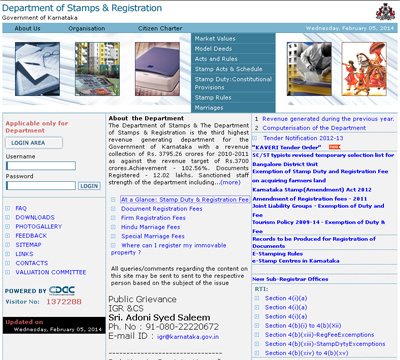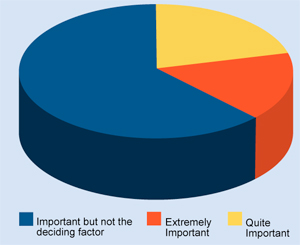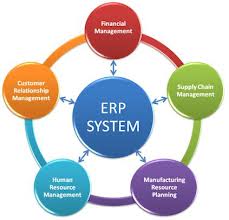|
How to Prepare for Google's 2014 Algorithm Updates

It has been an incredibly eventful year in terms of updates from Google. Major 2013 changes included further releases of Penguin and Panda, Hummingbird taking flight, and the shift away from providing keyword data thanks to encrypted search.
read more... |
6 Undeniable Reasons Why The Future of Web Design is Responsive

What’s the Difference Between Mobile and Responsive Design?
There are two major methods for creating a mobile websites Responsive Design and Mobile Templates.
read more...
|
|
 |
Web Portal for Department of stamps and registration - Government of Karnataka
Itech solution is redesigning the website for the Department of Stamps and Registrations, Government of Karnataka.
This being the first Government project for Itech, is a prestigious one. Among several vendors, Itech was selected for its best quality technology offering at a cost effective price. This portal for the Stamps and Registration Department, which is the third highest revenue generating department for the Government of Karnataka, is expected to generate lot of visibility and goodwill for Itech solutions.
DSR Admin can login to the Admin Page using the username and password. The Admin page will have options to create, edit and delete the dynamic content of the site (Images, Text and Forms).
read more... |

|
|
|
|
Role of Soft Skills in your Engineering Career

The most common HR question is: Beyond technical skills, experience and knowledge, what added value do you bring to the organisation? Of course, it is the soft skills that ensure success in your career. Here is what exactly are soft skills, why are they needed and what you can do to improve your soft skills.
read more...
|
Prominent Features of Enterprise Resource Planning

The Enterprise Resource Planning software authorizes business management in an organization. It has the benefit of integrating the different operations of a company to successful running of a business.
ERP comes in different modules to suit the specific needs of the company,
read more...
|
| |
|
Detailed Articles |
|
How to Prepare for Google's 2014 Algorithm Updates

It has been an incredibly eventful year in terms of updates from Google. Major 2013 changes included further releases of Penguin and Panda, Hummingbird taking flight, and the shift away from providing keyword data thanks to encrypted search.
Many have gone so far as to ask whether SEO as a profession is dead: for one interesting perspective, see my recent Forbes interview with Sam Roberts of VUDU Marketing. My own take is fewer alarmists: Google has taken major spam-fighting steps that have shifted the playing field for SEO professionals and anyone trying to get their site on the map in the year ahead.
At the same time, the need for an online presence has never been stronger, while the landscape has never been more competitive. The potential to make a real ROI impact with your company's online marketing initiative is greater than ever. But defaulting to so-called "gray hat" tactics no longer works. Instead, SEO professionals need to step up and embrace a more robust vision of our area of expertise.
You might call it a move from tactician to strategist: the best and most successful players in our space will work to anticipate Google's next moves and respond to them with laser focus. In a sense, the infinite digital game of chess that is SEO will continue, but the rules of the game have become more complex.
Through a mix of what I'm observing and reading and what I'm seeing working out in the field today for my clients, here are some suggestions for companies and SEO professionals that are thinking ahead to 2014 for their digital strategies.
Everything You Learned in 2013 is Still Relevant, Just Amplified
When you look closely at the targets of the 2013 updates (ie, websites that cheat their way to the top of the rankings or provide no value to visitors), I anticipate seeing these carried forward throughout 2014. We can continue to expect micro adjustments to Panda and Penguin that continue to target both link quality and content quality.
Smart marketers will benefit from keeping a close eye on their link profiles, and performing periodic audits to identify and remove inbound links built unnaturally. High quality content investments will remain critical.
A solid SEO performance in 2014 is going to be built on a foundation of really understanding what happened in 2013, and what these changes mean both strategically and tactically for SEO. SEO really has changed in critical ways.
Content Marketing is Bigger than Ever
Content marketing will move from buzzword to mature marketing movement in 2014. From an SEO perspective, Google will be looking at companies that have robust content marketing efforts as a sign that they're the kind of business Google wants to support.
Think of all the advantages of a good content strategy:
• Regular, helpful content targeted at your audience.
• Social signals from regular sharing and engagement.
• Freshness or signs that your site is alive and growing.
• Increasing authority connected to your body of work.
Sound familiar? It's the very approach to SEO that all of Google's recent updates have been designed to shape.
What changes you need to make in 2014 depends largely on where your company stands now in relation to an active content marketing strategy. Companies with existing content strategies will need to assess the role of mobile, specifically.
If you've just begun to move in the direction of content marketing, it's time to really commit and diversify. If you haven't started yet, it's time to take the plunge.
Social Media Plays an Increasingly Visible Role
Social media has been a major player in the digital marketing landscape for the last few years. First we saw the rise of mega platforms like Facebook and Twitter. In the last couple of years, visual content from networks like Pinterest, Instagram, and various micro-video services has swept through.
Today, diversification is a major trend: depending on who you're targeting, it's no longer enough to be active on a single network. In fact, The Content Marketing Institute recently released a study that the most successful B2B marketers are active on an average of seven networks.
Companies and SEO professionals will need to be asking the following questions in the year ahead:
• Are we taking our social media seriously? Are we employing the pillars of strong profiles, good content, reciprocity, and engagement?
• Is easy social sharing enabled for all of our content?
• Does our content strategy include a dissemination phase that includes maximizing its potential for distribution through social networks?
• Are we active on the social networks that matter in our industry?
• Are we active on the social networks that matter to our customers?
• Are we active on the social networks that matter to the search engines? (See below for more thoughts on making that strategic investment).
• Does our social media marketing strategy stimulate the level of social signals required to achieve our goals?
Google's updates are likely to increasingly rely on social signals as active human curation of good content.
Invest in Google+
In addition to strengthening your overall social media marketing position, it's going to be absolutely critical that you are investing in your Google+ presence.
Moz's most recent study of ranking factors confirms that Google+ is playing an increasingly significant role in a solid SEO ranking.
The immediate areas to focus on include
• Establishing Google Authorship of your content, and tying it to your Google+ account. Authorship, which brings your body of content together, will play an important role in the SERPs as well as strengthening your Author Rank.
• Those +1's add up. It isn't clear exactly how much Google +1's directly contribute, but it's fair to say that it's a major factor in the "social signals" component of Google's algorithm. I expect this to increase in the year ahead.
Hummingbird Was Just the Tip of the Mobile Iceberg
2014 will be the year of mobile SEO. Hummingbird was just the very small visible tip of a very large iceberg as Google struggles to respond to the rapidly shifting landscape where half of all Americans own smartphones and at least one-third own tablets. Those statistics will probably shift upward, maybe dramatically, after the 2013 holiday season.
As a result, your site's mobile performance matters to your SEO rankings. Properties that you're trying to rank need to be designed first for mobile and then scaled up for the big screen. If you don't have a mobile-optimized website, this needs to be your top priority in terms of SEO and design investments for 2014.
Some underlying changes that happened with Hummingbird, including the increasing importance of both semantic search and Knowledge Graph, will continue to grow in influence. Practically speaking, this is to help prepare the search engine for the rise of voice search associated with mobile. But it also has direct implications (which we're still learning about) for broader SEO. This is one area that you should pay close attention to, from how you structure your content to what content you choose to put out.
The Long versus Short Debate
Which is better, long content or short content? The answer depends on who is creating the content, who is reading it, what it's about, in what context it's being consumed, and how you define "better."
For the purposes of this argument, which form of content will help you best prepare to rank well in 2014? Frustratingly for some, the answer is more "both/and" than "or."
Vocus recently cited a study that showed that the top 10 results for a specific keyword search tended to be more than 2,000 words in length. The validity of that study has been debated, but it's probably fair to say that length is a proxy for depth of expertise and value delivered to the reader.
Google values both expertise and value. As a result, we've seen a trend where the "minimum desirable length" for text-based content has shifted from something in the range of 550 words to articles in the range of 1000-plus words.
Yet we're also confronted with the reality of the mobile device: if I'm reading about something I'm only moderately interested in, there's a high probability that I won't want to scroll through 2,000 words on my iPhone. That leaves content marketers faced with the challenge of producing mobile-friendly content, which tends to be (in a sweeping generality) much, much shorter.
Proposed solutions have run the gamut from content mixes to site architectures that allow you to point readers to specific versions of content based on their devices. This is great for the user experience, but where it all comes out on the SEO algorithm front remains to be seen. For now, I'll just acknowledge that it's an area of concern that will continue to evolve and that it's something you should keep your eye on.
Advertising and PPC has a Shifted Relationship with SEO
Since Google made the decision to encrypt the vast majority of its searches, our ability to access keyword data for research purposes has been restricted. However, there's a loophole. Keyword data is still available for advertisers using PPC on Google's platform.
More SEO budgets may be driven toward PPC simply because access to the data may otherwise be restricted. It's also possible that we'll see the release of a premium Google product to give us access to that data through another channel from Google in the year ahead.
Guest Blogging Remains One of the Most Effective Tactics, With a Caveat
Guest blogging has exploded in the past year, and it's going to remain one of the most effective means of building quality inbound links, traffic, and branding exposure in 2014. However, it's absolutely critical that you're creating high quality content, and using extremely stringent criteria when selecting your target sites.
In other words, you need to apply the same high ethos approach to guest blogging that you do to the rest of your SEO efforts. If you dip a toe into spammy waters where guest blogging is essentially scattershot article marketing with a 2014 update, you're likely to be penalized in a future Penguin update.
Article Source
|
|
|
6 Undeniable Reasons Why The Future of Web Design is Responsive

What’s the Difference Between Mobile and Responsive Design?
There are two major methods for creating a mobile websites Responsive Design and Mobile Templates. Responsive design requires you only have one website that is coded to adapt to all screen size no matter what the device it’s being displayed on.
In contrast, a mobile template is a completely separate entity requiring you to have a second mobile only website or sub-domain. Mobile templates are also built for each specific, not per screen size. This can cause some issues as we will discuss below.
Responsive design, a term originally coined in a 2010 A List Apart article by Ethan Marcotte, responsive design has been by far the most popular and widely used method for designing a mobile website. Here are just a few of the undeniable reasons your website needs to be responsive.
1. Mobile Usage is Exploding
This might not be a surprise for most of you, yet despite the impressive statistics below many businesses do not yet have a mobile website. Hopefully reading through these statistics will light a fire to stop ignoring the need for a mobile website.
Over 20% of Google searches are being performed on a mobile device.
In 2012 more than half of the local searches were performed on a mobile device.
In the United States, 25% of internet users only access the internet on a mobile device
61% of people have a better opinion of brands when they offer a good mobile experience
25.85% of all emails are opened on mobile phones, and 10.16% are opened on tablets.
(via Smart Insights)
2. Positive User Experience Is Key
According to Google’s Think Insights on Mobile, if a user lands on your mobile website and is frustrated or doesn’t see what they are looking for, there’s a 61% chance they will leave immediately and go to another website (most likely a competitor). It’s also said that if they have a positive experience with your mobile website a user is 67% more likely to buy a product or use a service.
3. Blogging and Social Activities Bring Mobile Visitors
If you’re like most Inbound Marketers and have elements of blogging and social media incorporated in your strategy, you probably have been seeing increased mobile traffic. A recent study by ComScore cites that 55% of social media consumption happens on a mobile device.
With this being said, if you are sharing out content links or links to your website and don’t have a mobile friendly website, you’re not only going to experience high bounce rates and low conversion rates but also a frustrated audience.
4. Responsive Design is Preferred for SEO
In June 2012 at SMX Advanced, Google’s Pierre Farr went on the record to declare that Google prefers responsive web design over mobile templates. Having one single URL makes it easier for Google bot to crawl your site, Google’s external link algorithm and reduces the chance of on-page SEO errors. For all these reasons, responsive sites typically perform better and are easier to maintain than a separate, mobile template site.
5. A Speedy Responsive Website is Key
According to the Google PageSpeed Developers standards recommends that the content above the fold on a mobile device loads in under 1 second and the entire page loads in under 2 seconds. This is typically not possible when loading a desktop website on a mobile device. When a user has to wait too long for a page to load, there’s an extremely high chance they will leave your site.
Curious about how well your current website is performing on a mobile device? Google Developers has this nifty little tool to check your mobile site’s speed. Test it now!
6. Responsive Adapts to Future Devices
One of the big benefits of responsive design is that the size of the template is designed based on screen size not device. This means that no matter what size screen someone is viewing your website it will display properly for that screen size. So in the future as new devices (TVs, watches, glasses, etc.) are being used for web browsing, your responsive site will still look beautiful.
Moving forward it will be extremely critical that your website provides mobile users an easy-to-use experience. Having a mobile website is no longer a simply a nice feature, rather it is a necessity and literally impact the growth of your business.
Are you curious the possible return having a mobile website might have? I’d suggest checking out is this “Full Value of Mobile” calculator by Google. Here you can input different variables about your business and marketing and it will give you a full run down of how your metrics can be increased with proper mobile design.
If you have any questions or have comments on this topic, I’d encourage you to post in the comments below and I’d love to chat.
The resident Director of Inbound Marketing at Savvy Panda, Luke Summerfield and his team develop web and marketing success stories for medium to fortune 100 companies and nonprofits. Luke is also the head instructor of Master Inbound, a comprehensive online Inbound Marketing training course.
Article Source |
|
|
Web Portal for Department of stamps and registration - Government of
Karnataka

Itech solution is redesigning the website for the Department of Stamps and Registrations, Government of Karnataka.
This being the first Government project for Itech, is a prestigious one. Among several vendors, Itech was selected for its best quality technology offering at a cost effective price. This portal for the Stamps and Registration Department, which is the third highest revenue generating department for the Government of Karnataka, is expected to generate lot of visibility and goodwill for Itech solutions.
DSR Admin can login to the Admin Page using the username and password. The Admin page will have options to create, edit and delete the dynamic content of the site (Images, Text and Forms).
It includes reports, statistics to view the details related to the DSR and also have search to view the details related to the DSR. The roles provided are Super admin and admin and this development is going to be in Dot Net technology. The whole website will be done using "Responsive Web Design" using latest technologies like HTML5 and CSS3.
Website is being developed in both Kannada and English, Kannada being the default language. The UI will be designed to be user friendly so that citizens can easily find what they are looking for. Various important documents, forms and guidelines are available for Download from the Website.
Google Maps will be implemented for all the Sub Registrar offices. The address will be linked to latitude and longitude of the particular Office so that the user can locate the Sub Registrar office nearest to his location.
|
|
|
Role of Soft Skills in your Engineering Career

In India, electronics engineering as a career has always attracted the student community in a big way. Testimony to this fact is an ever-increasing number of aspirants taking various entrance exams to qualify and enroll for their choice of engineering branch.
Throughout the course, one learns and specialises in a particular branch of engineering theoretically and practically. However, just technical skills are not enough as the most common HR question is: Beyond technical skills, experience and knowledge, what added value do you bring to the organisation? Therefore soft skills are critical to make you employable.
What exactly are soft skills?
Naresh Narasimhan, country marketing manager, Tektronix, says, “In the 21st century and going forward, three things are important—ability to communicate an idea visually, ability to have a balanced point-of-view on key issues and ability to convert ideas to results.”
The concept of soft skills is not limited to just plain communication skills but it also includes aspects such as people skills.
Dr Pallab Bandyopadhyay, director-HR, Citrix India, explains: “In the broader context, soft skills would also include negotiation, decision making, reasoning and problem solving, and conflict-resolution skills required in today’s work environment.”
“While technical professionals are often selected and trained based on measurable talents and skills such as knowledge of OS or software programming skills—which are prerequisites to starting a career in engineering and technology—intangible skills such as language proficiency, ability to work with global teams and positive attitude often count in making their career a rewarding one. These intangible skills are classified as soft-skills,” adds Sudhanshu Pandit, director-HR, Symantec India.
When evaluating a candidate on soft skills, HR professionals look at not only his ability to communicate his thoughts clearly and concisely but also his personality and problem-solving skills.
Defining soft skills, John Prohod-sky, founder and principal consultant, Future Envisioned, says, “Soft skills are non-technical, interpersonal and communication skills required by an engineer to successfully solve problems and apply his technical skills.”
Throwing light on how soft skills are directly proportional to one’s personality, Rajesh Choudhary, HR head, Xilinx India, says, “Personality traits such as common sense, optimism, responsibility, integrity, attitude and behavioural competencies that include analytical thinking, result orientation and achievement, communication, teamwork, conflict management, customer orientation and attention to details come under soft skills.”
As soft skills cover all the aspects related to human behaviour, Zubin Rashid, managing partner and head of training, ZRINDIA, believes that “Just as hard skills teach us about domain-specific skills like technology, products and processes, soft skills are about interacting with people with whom you work.”
Every company looks for a different mix of skills and experience and it is not enough just to be a subject matter expert. Communication is an integral part of soft skills.
Surinder Bhagat, country HR head, Freescale Semiconductor, India, says, “Soft skills can also refer to a set of skills that determine how one interacts with others in a way that the company as such gets represented well. These skills are applicable to all internal as well as external forums where employees are making key interactions.”
Tina Vas, vice president-global HR, Collabera, says “Simply put, soft skills have more to do with who we are than what we know.”
Soft skills critically impact the way an individual translates his expertise across to his team and further to the whole organisation.
Ramana Vemuri, VP-process and operations, Cigniti Technologies, believes that soft skills enhance an individual’s interactions, job performance and career prospects. According to him, emotional intelligence is the critical element that defines the core of soft skills a person is equipped with.
Soft skills in today’s India
According to a recent report by employability assessment company Aspiring Minds, 56 per cent engineering graduates in India lack soft skills and cognitive skills. Non-technical aspects of engineering such as communications, relationships, temperament, emotional intelligence and risk management make a difference between success and failure. Understanding and adapting to the working environment is just as crucial as getting the job itself.
Prohodsky says, “Engineering is the application of hard sciences to solve real problems but what they rarely teach in colleges is that engineering, in addition to being a technical activity, is an economic activity and, most importantly, a human activity.”
According to him, the ability to understand company and work team culture is the most under-appreciated soft skill.
Bhagat says, “As companies become more global, soft skills are highly desirable and required in more positions now than ten or even five years ago. You may have an excellent knowledge base in engineering or technology, perhaps even a PhD, and maybe bilingual but if you have not developed good skills in communicating, interacting and people resource management, you have already limited your opportunities and chance of success.”
Vas adds, “Networking is also important; engineers need to keep in touch with alumni as well as industry experts via various interactive forums to understand the ground realities better.”
Why you should continuously improve your soft skills
“Soft skills are applied emotional intelligence and as such, they are very important. As engineers, we are taught to think and apply the logic of math and science. However, we are being ruled by emotions,” says Prohodsky.
Soft skills are very essential for personal and professional development of individuals. “In today’s economy, it is even more important considering a significant portion of Indian GDP comes from services sector. To support this growth in services sector, organisations require talents who possess greater soft skills along with hard skills,” notes Rajesh Choudhary.
“Technical skills may take you to the doorstep but it is your soft skills that will open up the door for you,” believes Dr Pallab.
Adding on the growing importance of soft skills in today’s world, Vemuri says, “They (soft skills) are in demand than ever. Increasing possibility of interactions with global peers, customers, virtual teams and cross-cultural discussions mandate employers to look out for fine-tuned, polished workforce.”
“Soft skills facilitate efficiency and effectiveness at work,” says Sunil Pathak, HR director, Cadence Design Systems. While flawless technical expertise is the primary necessity, soft skills are imperative to ensure high-quality contribution and delivery.
Pandit explains, “An engineer might be excellent at writing code to solve a particular problem but unless he possesses soft skills, he would neither be able to understand the problem faced by a customer nor explain how his suggested method makes the best fitted solution for the customer’s problem.”
Dr Pallab believes that soft skills are as important as technical skills due to two main factors: “One is that employees are being sent on projects to international locations, where they need to articulate their thoughts and actions to become productive. Second, with enhanced globalisation, virtual communication has taken a front seat in today’s organisations.”
An engineer is rewarded for his ability to make decisions, manage risks and creativity. Therefore soft skills are vital for an individual to get employed and grow in an organisation.
Article Source
|
|
Prominent Features of Enterprise Resource Planning

The Enterprise Resource Planning software authorizes business management in an organization. It has the benefit of integrating the different operations of a company to successful running of a business.
ERP comes in different modules to suit the specific needs of the company, irrespective of its size whether small or medium or large scale industry. The main aim of this software is to integrate all the modules and to provide a centralized and unified repository for all the details that can be shared by all the departments for quick and smooth functioning of the company.
The Enterprise Resource Planning is also used for tracking a customer order from right one when order comes in date of delivery. The whole process can be tracked with clarity. ERP process can be standardized the different process and to accelerate the manufacturing & automated functions. It also improves the productivity of the enterprise.
It is a software package which is developed for optimum use of resources of an enterprise in a planned manner. This software enables the enterprise to increase the productivity by decreasing the costs.
Prominent Features of Enterprise Resource Planning:
It has a central database shared by all functions of the enterprise.
The enterprise resource planning is the information backbone of the company.
The information is transparent and it has automatic and consistent work flow from one department to another.
With this one can easily track the inventory, revenue as well as forecasting of sales and related activities.
It serves as the central nervous system termed as the digital nervous system of the company.
In manufacturing sector it was primarily to know about the stock of finished goods and to understand the movement of the material.
The Enterprise resource planning is built as open system architecture that allows automatic introduction of the latest technologies such as EFT, EDI, internet, intranet, video conferring, ecommerce etc. it is good solution for better project management.
Reduction in operational costs: To deploy ERP software holds benefits for all three process streams of an organization- strategic planning, production and management control. An ERP software system let you maintain detailed inventory records, keep a track of materials a lot and also simplify your Inventory transitions.
Rationalize of Day to Day Management: The Enterprise resource planning system rationalizes the process involved in carrying out the day to day tasks of managing the business. It is mainly because this software facilities the creation of backbone data warehousing system.
Resource Planning:The resource planning forms an integral module of the strategic planning which is carried out in organization. These systems are therefore designed to take on the tasks involved in planning resources efficiently and effectively.
Article Source
|
|
|
Itech Solutions |
|













